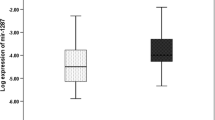Abstract
Background
MicroRNAs (miRNAs), small noncoding RNAs, have been reported to be highly involved in the formation and progression of all types of human cancer including colorectal cancer (CRC). Therefore, miRNAs are also potential prognostic biomarkers in CRC patients. The aim of this study was to detect the expression of miR-16 in human CRC tissues and investigate its clinicopathologic or prognostic significance.
Methods
TaqMan quantitative reverse transcription polymerase chain reaction (qRT-PCR) assay was performed to determine the expression of miR-16 in 143 primary CRC tissues and 18 corresponding normal colonic mucosa from patients who had undergone surgery. The association of miR-16 expression with clinicopathologic features of CRC patients was statistically analyzed. Kaplan–Meier analyses were used to assess patient survival. Univariate and multivariate Cox analyses were performed.
Results
The relative level of miR-16 in 18 CRC tissues was significantly lower than that in corresponding normal colonic mucosa (p < 0.001). Statistical analyses revealed that the status of miR-16 expression was closely associated with tumor differentiation, lymph node metastasis, L category, V category, TNM stage, and tumor recurrence of CRC (p = 0.001, 0.003, 0.001, 0.005, 0.003, and 0.017, respectively). Kaplan–Meier analyses indicated that patients with low-miR-16 had lower 5-year overall survival than those with high-miR-16 (31.2 vs. 58.3 %; p = 0.0012). Multivariate Cox regression analyses indicated that the status of miR-16 expression might be an independent prognostic factor for CRC patients (hazard ratio 1.67; 95 % confidence interval 1.22–2.54; p = 0.018).
Conclusions
Down-regulation of miR-16 plays critical roles in CRC progression. Low miR-16 expression is an independent factor predicting a poor prognosis for CRC patients.


Similar content being viewed by others
References
Center MM, Jemal A, Smith RA et al (2009) Worldwide variations in colorectal cancer. CA Cancer J Clin 59:366–378
Bolocan A, Ion D, Ciocan DN et al (2012) Prognostic and predictive factors in colorectal cancer. Chirurgia (Bucur) 107:555–563
Ke XS, Liu CM, Liu DP et al (2003) MicroRNAs: key participants in gene regulatory networks. Curr Opin Chem Biol 7:516–523
Bartel DP (2004) MicroRNAs: genomics, biogenesis, mechanism, and function. Cell 116:281–297
Jansson MD, Lund AH (2012) MicroRNA and cancer. Mol Oncol 6:590–610
Shen J, Stass SA, Jiang F (2013) MicroRNAs as potential biomarkers in human solid tumors. Cancer Lett 329:125–136
Garzon R, Marcucci G (2012) Potential of microRNAs for cancer diagnostics, prognostication and therapy. Curr Opin Oncol 24:655–659
Takeshita F, Patrawala L, Osaki M (2010) Systemic delivery of synthetic microRNA-16 inhibits the growth of metastatic prostate tumors via downregulation of multiple cell-cycle genes. Mol Ther 18:181–187
Agra Andrieu N, Motiño O, Mayoral R (2012) Cyclooxygenase-2 is a target of microRNA-16 in human hepatoma cells. PLoS One 7:e50935
Ma Q, Wang X, Li Z et al (2013) microRNA-16 represses colorectal cancer cell growth in vitro by regulating the p53/survivin signaling pathway. Oncol Rep 29:1652–1658
Bendardaf R, Lamlum H, Pyrhönen S (2004) Prognostic and predictive molecular markers in colorectal carcinoma. Anticancer Res 24:2519–2530
Pasche B, Mulcahy M, Benson AB 3rd (2002) Molecular markers in prognosis of colorectal cancer and prediction of response to treatment. Best Pract Res Clin Gastroenterol 16:331–345
Schetter AJ, Okayama H, Harris CC (2012) The role of microRNAs in colorectal cancer. Cancer J 18:244–252
Corté H, Manceau G, Blons H et al (2012) MicroRNA and colorectal cancer. Dig Liver Dis 44:195–200
Weiland M, Gao XH, Zhou L et al (2012) Small RNAs have a large impact: circulating microRNAs as biomarkers for human diseases. RNA Biol 9:850–859
Zhou L, Zhao YP, Liu WJ et al (2012) Circulating microRNAs in cancer: diagnostic and prognostic significance. Expert Rev Anticancer Ther 12:283–288
Li J, Du L, Yang Y et al (2013) MiR-429 is an independent prognostic factor in colorectal cancer and exerts its anti-apoptotic function by targeting SOX2. Cancer Lett 329:84–90
Nishimura J, Handa R, Yamamoto H et al (2012) MicroRNA-181a is associated with poor prognosis of colorectal cancer. Oncol Rep 28:2221–2226
Wang Q, Huang Z, Ni S et al (2012) Plasma miR-601 and miR-760 are novel biomarkers for the early detection of colorectal cancer. PLoS One 7:e44398
Pichler M, Winter E, Stotz M et al (2012) Down-regulation of KRAS-interacting miRNA-143 predicts poor prognosis but not response to EGFR-targeted agents in colorectal cancer. Br J Cancer 106:1826–1832
Xi Y, Li J, Zan L et al (2013) Micro-RNA-16 expression in paraffin-embedded specimen correlates with overall survival of T-lymphoblastic lymphoma/leukemia. Hum Pathol 44:1011–1016
Navarro A, Diaz T, Gallardo E et al (2011) Prognostic implications of miR-16 expression levels in resected non-small-cell lung cancer. J Surg Oncol 103:411–415
Gao X, Zhang R, Qu X et al (2012) MiR-15a, miR-16-1 and miR-17-92 cluster expression are linked to poor prognosis in multiple myeloma. Leuk Res 36:1505–1509
Wu H, Liu T, Wang R et al (2011) MicroRNA-16 targets zyxin and promotes cell motility in human laryngeal carcinoma cell line HEp-2. IUBMB Life 63:101–108
McShane LM, Altman DG, Sauerbrei W et al (2005) REporting recommendations for tumour MARKer prognostic studies (REMARK). Eur J Cancer 41:1690–1696
Acknowledgments
The authors thank Professor Ming Zhang for expert advice on pathology. We also thank everyone in the Department of Pathology for their technical assistance.
Author information
Authors and Affiliations
Corresponding author
Electronic supplementary material
Below is the link to the electronic supplementary material.
268_2013_2205_MOESM1_ESM.tif
Supplementary Fig. S1 A ROC curve for survival prediction was plotted to identify the optimum cutoff point for miR-16 in CRC, which was 0.52. The area under the curve for miR-16 was 70.5 % (95 % confidence interval 0.678–0.768) with sensitivity of 63.6 % and specificity of 74.4 % (p = 0.012) Supplementary material 1 (TIFF 14 kb)
Rights and permissions
About this article
Cite this article
Qian, J., Jiang, B., Li, M. et al. Prognostic Significance of MicroRNA-16 Expression in Human Colorectal Cancer. World J Surg 37, 2944–2949 (2013). https://doi.org/10.1007/s00268-013-2205-4
Published:
Issue Date:
DOI: https://doi.org/10.1007/s00268-013-2205-4




